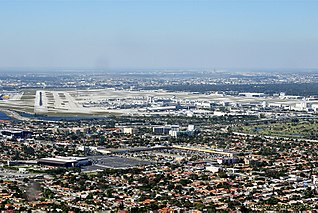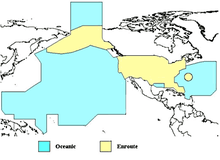
An airline is a company that provides air transport services for traveling passengers and/or freight. Airlines use aircraft to supply these services and may form partnerships or alliances with other airlines for codeshare agreements, in which they both offer and operate the same flight. Generally, airline companies are recognized with an air operating certificate or license issued by a governmental aviation body. Airlines may be scheduled or charter operators.
PJSC Aeroflot – Russian Airlines, commonly known as Aeroflot, is the flag carrier and the largest airline of Russia. The airline was founded in 1923, making Aeroflot one of the oldest active airlines in the world. Aeroflot is headquartered in the Central Administrative Okrug, Moscow, with its hub being Sheremetyevo International Airport.

Miami International Airport, also known as MIA and historically as Wilcox Field, is the primary airport serving the greater Miami metropolitan area with over 1,000 daily flights to 167 domestic and international destinations, including most countries in Latin America. The airport is in an unincorporated area in Miami-Dade County, 8 miles (13 km) northwest of Downtown Miami, in metropolitan Miami, adjacent to the cities of Miami and Miami Springs, and the village of Virginia Gardens. Nearby cities include Hialeah, Doral, and the Census-designated place of Fontainebleau.

Northwest Airlines Corp. (NWA) was a major American airline founded in 1926 and absorbed into Delta Air Lines by a merger that was approved in 2008. Northwest continued to operate under its own name and brand until the integration of the carriers was completed in 2010. The merger made Delta the largest airline in the world until the American Airlines–US Airways merger in 2013.
Air Wisconsin Airlines is a regional airline based at Appleton International Airport in the town of Greenville, Wisconsin, near Appleton. Air Wisconsin originally operated as one of the original United Express partners in 1985, and operated then as US Airways Express on behalf of US Airways prior to becoming an American Eagle regional air carrier. Between March 2018 and April 2023, Air Wisconsin operated exclusively as a United Express regional air carrier once again with primary hubs located at Chicago's O'Hare International Airport (ORD) and Washington Dulles International Airport (IAD). This came to an end in April 2023 as the carrier switched to conducting solely American Eagle branded flights, per a new contract with American Airlines.
China Southern Airlines Company Limited, also known as China Southern, is an airline headquartered in Baiyun District, Guangzhou, Guangdong Province and is the largest airline in China. Established on 1 July 1988 following the restructuring of the CAAC Airlines that acquired and merged a number of domestic airlines, the airline became one of China's "Big Three" airlines, the world's sixth-largest airline measured by passengers carried and Asia's largest airline in fleet size, revenue, and passengers carried. With its main hubs at Guangzhou Baiyun International Airport and Beijing Daxing International Airport, the airline operates more than 2,000 flights to more than 200 destinations daily and was a member of SkyTeam until 1 January 2019. The airline started a frequent flyer program partnership with American Airlines in March 2019. The logo of the airline consists of a kapok flower on a blue tail fin. The company slogan is Fly towards your dreams.
The Bermuda Agreement, reached in 1946 by American and British negotiators in Bermuda, was an early bilateral air transport agreement regulating civil air transport. It established a precedent for the signing of approximately 3,000 other such agreements between countries. The Agreement was replaced by the Bermuda II Agreement, which was signed in 1977 and effective in 1978.
Cabotage is the transport of goods or passengers between two places in the same country. It originally applied to shipping along coastal routes, port to port, but now applies to aviation, railways, and road transport as well.

An airline hub or hub airport is an airport used by one or more airlines to concentrate passenger traffic and flight operations. Hubs serve as transfer points to help get passengers to their final destination. It is part of the hub-and-spoke system. An airline may operate flights from several non-hub (spoke) cities to the hub airport, and passengers traveling between spoke cities connect through the hub. This paradigm creates economies of scale that allow an airline to serve city-pairs that could otherwise not be economically served on a non-stop basis. This system contrasts with the point-to-point model, in which there are no hubs and nonstop flights are instead offered between spoke cities. Hub airports also serve origin and destination (O&D) traffic.
Bermuda II was a bilateral air transport agreement between the governments of the United Kingdom and the United States signed on 23 July 1977 as a renegotiation of the original 1946 Bermuda air services agreement. A new open skies agreement was signed by the United States and the European Union (EU) on 30 April 2007 and came into effect on 30 March 2008, thus replacing Bermuda II.
Aviation in Singapore is a key component of the Singaporean economy. Besides currently the sixth busiest airport and the fourth busiest air cargo hub in Asia, the Singaporean aviation industry is also a significant aerospace maintenance, repair and overhaul centre.

Pago Pago International Airport, also known as Tafuna Airport, is a public airport located 7 miles (11.3 km) southwest of the central business district of Pago Pago, in the village and plains of Tafuna on the island of Tutuila in American Samoa, an unincorporated territory of the United States.
The EU–US Open Skies Agreement is an open skies air transport agreement between the European Union (EU) and the United States (US). The agreement allows any airline of the European Union and any airline of the United States to fly between any point in the European Union and any point in the United States. Both EU and US airlines are allowed to fly on to a further destination in another country after their initial stop. Because the EU is not treated as a single territory for the purposes of the agreement, this means in practice that US airlines can fly between two points in the EU as long as that flight is the continuation of a flight that started in the US. Airlines of the EU are also allowed to fly between the US and non-EU countries that are part of the European Common Aviation Area, like Switzerland. EU and US airlines can operate all-cargo flights under Seventh Freedom rights, meaning US airlines' all-cargo flights can be operated from one EU country to any other country and EU airlines' all-cargo flights can operate between the US and any other country. Norway and Iceland acceded to the Agreement from 2011 and their airlines enjoy the same rights as EU airlines.
There are bilateral treaties that govern aviation rights between the United States and China, which cover both passenger services and cargo services. The United States has liberal aviation agreements with many countries but not China, South Africa, and some South American countries. However, there is no "open skies" agreement between China and the US, which generally refers to an agreement that allows unrestricted flights between countries. The current US-China treaty specifies the number of flights permitted. Due to the highly regulated nature of awards for route authority between the two countries and the strict limits on number of flights, the application process is competitive. US airlines have sought to gain support from local politicians and the general public to influence the US government into awarding routes.

As of December 2017, there are 229 commercial airports in China.

The so-called "Emirates business model" is the business model that lies at the heart of Emirates's commercial success. Its main ingredients are a lean workforce comparable to a low-cost carrier and a flat organisational structure that allows the airline to maintain low overhead costs.

Aviation in Indonesia serves as a critical means of connecting the thousands of islands throughout the archipelago. Indonesia is the largest archipelagic country in the world, extending 5,120 kilometres (3,181 mi) from east to west and 1,760 kilometres (1,094 mi) from north to south, comprising 13,466 islands, with 922 of those permanently inhabited. With an estimated population of over 255 million people — making it the world's fourth-most-populous country — and also due to the growth of the middle-class, the boom of low-cost carriers in the recent decade, and overall economic growth, many domestic travellers shifted from land and sea transport to faster and more comfortable air travel. Indonesia is widely regarded as an emerging market for air travel in the region. Between 2009 and 2014, the number of Indonesian air passengers increased from 27,421,235 to 94,504,086, an increase of over threefold.

Civil aviation in India, the world's third-largest civil aviation market as of 2020, traces its origin back to 1911, when the first commercial civil aviation flight took off from a polo ground in Allahabad carrying mail across the Yamuna river to Naini.

The Single African Air Transport Market (SAATM) is a project of the African Union to create a single market for air transport in Africa. Once completely in force, the single market is supposed to allow significant freedom of air transport in Africa, advancing the AU's Agenda 2063.

The Yamoussoukro Decision is a treaty adopted by most members of the African Union (AU) which establishes a framework for the liberalization of air transport services between African countries, as well as fair competition between airlines. The decision was signed by 44 African states in 1999, and became binding in 2002.












